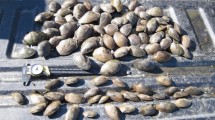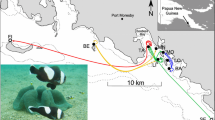Abstract
Hydrologic restriction of salt marshes and subsequent invasion by Phragmites australis could influence the reproductive success of Fundulus heteroclitus, a common salt marsh resident that forages and spawns on the marsh surface at flood tide. Previous research in our laboratory using data from 2010 to 2011 examined the proportion of actively spawning F. heteroclitus residing in altered New England salt marshes as part of a larger experiment to examine the physiological condition of fish in restricted and restored marshes relative to paired unrestricted (reference) sites. We detected a significant decrease in the proportion of actively spawning fish in restricted relative to paired unrestricted marshes, but no difference between restored and paired unrestricted marsh fish. In this manuscript, we conduct a re-analysis of a portion of that data (July 2011) to explore potential mechanisms behind previous results. Using forward stepwise selection and generalized linear mixed models, we determined that the reduction in actively spawning restricted marsh fish was due to a single predictor (lipid mass); there were no effects of water temperature, body size, parasite prevalence, parasite density, and growth rate on the response. Previous results indicate healthy restricted marsh fish already have reduced energy reserves. Since investment in oocytes is energetically costly (this analysis), the effect could manifest at the population level as a reduction in actively spawning fish. In addition, oocyte quality is reduced in restricted marshes (as measured by % lipid; 13.9 ± 1.6 % SD) relative to paired unrestricted marshes (15.9 ± 2.3 % SD). Although these data are preliminary and represent a single lunar cycle, additional studies are warranted to explore relationships between P. australis invasion, restoration, and effects on the fecundity of this ubiquitous salt marsh fish.


Similar content being viewed by others
References
Able KW, Felley JD (1986) Geographical variation in Fundulus heteroclitus: tests for concordance between egg and adult morphologies. Am Zool 26:145–157
Able KW, Hagan SM (2000) Effects of common reed (Phragmites australis) invasion on marsh surface macrofauna: response of fishes and decapod crustaceans. Estuaries 23:633–646
Able KW, Hagan SM (2003) Impact of common reed, Phragmites australis, on essential fish habitat: influence on reproduction, embryological development, and larval abundance of mummichog (Fundulus heteroclitus). Estuaries 26:40–50
Able KW, Hagan SM, Brown SA (2003) Mechanisms of marsh habitat alteration due to Phragmites: response of young-of-the-year Mummichog (Fundulus heteroclitus) to treatment for Phragmites removal. Estuaries 26:484–494
Black DE, Gutjahr-Gobell R, Pruell RJ et al (1998) Effects of a mixture of non-ortho-and mono-ortho-polychlorinated biphenyls on reproduction in Fundulus heteroclitus (Linnaeus). Environ Toxicol Chem 17:1396–1404
Brown-Peterson NJ, Wyanski DM, Saborido-Rey F et al (2011) A standardized terminology for describing reproductive development in fishes. Marine Coast Fish 3:52–70
Bush AO, Lafferty KD, Lotz JM et al (1997) Parasitology meets ecology on its own yerms: Margolis et al. revisited. J Parasitol 83:575–583
Chambers RM, Meyerson LA, Saltonstall K (1999) Expansion of Phragmites australis into tidal wetlands of North America. Aquat Bot 64:261–273
Chambers RM, Meyerson LA, Dibble KL (2012) Ecology of Phragmites australis and responses to tidal restoration. In: Roman C, Burdick D (eds) Tidal marsh restoration: a synthesis of science and management. Island Press, Washington, DC, pp 81–96
Dibble KL, Meyerson LA (2012) Tidal flushing restores the physiological condition of fish residing in degraded salt marshes. PLoS ONE 7:e46161
Dibble KL, Meyerson LA (2013) The effects of plant invasion and ecosystem restoration on energy flow through salt marsh food webs. Estuaries Coasts 37:339–353
Farnsworth EJ, Meyerson LA (2003) Comparative ecophysiology of four wetland plant species along a continuum of invasiveness. Wetlands 23:750–762
Hunter KL, Fox DA, Brown LM et al (2006) Responses of resident marsh fishes to stages of Phragmites australis invasion in three mid Atlantic estuaries. Estuaries Coasts 29:487–498
Javonillo R, Deegan L, Chiaravalle K et al (1997) The importance of access to salt-marsh surface to short-term growth of Fundulus heteroclitus in a New England salt marsh. Biol Bull 193:288–289
Jorgensen C, Ernande B, Fiksen O et al (2006) The logic of skipped spawning in fish. Can J Fish Aquat Sci 63:200–211
Kneib RT (1986) Size-specific patterns in the reproductive cycle of the killifish, Fundulus heteroclitus (Pisces, Fundulidae) from Sapelo Island, Georgia. Copeia 1986:342–351
Kneib RT, Stiven AE (1978) Growth, reproduction, and feeding of Fundulus heteroclitus (L.) on a North Carolina salt marsh. J Exp Mar Biol Ecol 31:121–140
McBride RS, Somarakis S, Fitzhugh GR et al (2015) Energy acquisition and allocation to egg production in relation to fish reproductive strategies. Fish Fish 16:23–57
McMullin VA, Munkittrick KR, Methven DA (2009) Latitudinal variability in lunar spawning rhythms: absence of a lunar pattern in the northern mummichog Fundulus heteroclitus macrolepidotus. J Fish Biol 75:885–900
Meyerson LA, Saltonstall K, Windham L et al (2000) A comparison of Phragmites australis in freshwater and brackish marsh environments in North America. Wetl Ecol Manag 8:89–103
Minello TJ, Able KW, Weinstein MP et al (2003) Salt marshes as nurseries for nekton: testing hypotheses on density, growth and survival through meta-analysis. Mar Ecol Prog Ser 246:39–59
Osgood DT, Yozzo DJ, Chambers RM et al (2003) Tidal hydrology and habitat utilization by resident nekton in Phragmites and non-Phragmites marshes. Estuaries 26:522–533
Ott RL, Longnecker M (2010) An introduction to statistical methods and data analysis. Brooks/Cole, Belmont
Petersen CW, Salinas S, Preston RL, et al (2010) Spawning periodicity and reproductive behavior of Fundulus heteroclitus in a New England salt marsh. Copeia 2010:203–210
Portnoy JW, Giblin AE (1997) Effects of historic tidal restrictions on salt marsh sediment chemistry. Biogeochemistry 36:275–303
Post D, Layman C, Arrington DA et al (2007) Getting to the fat of the matter: models, methods and assumptions for dealing with lipids in stable isotope analyses. Oecologia 152:179–189
Raposa K (2002) Early responses of fishes and crustaceans to restoration of a tidally restricted New England salt marsh. Restor Ecol 10:665–676
Raposa KB (2008) Early ecological responses to hydrologic restoration of a tidal pond and salt marsh complex in Narragansett Bay, Rhode Island. J Coast Res 55:180–192
Raposa KB, Roman CT (2003) Using gradients in tidal restriction to evaluate nekton community responses to salt marsh restoration. Estuaries 26:98–105
Roman CT, Niering WA, Warren RS (1984) Salt marsh vegetation change in response to tidal restriction. Environ Manag 8:141–149
Rooth JE, Stevenson JC, Cornwall JC (2003) Increased sediment accretion rates following invasion by Phragmites australis: the role of litter. Estuaries 26:475–483
Shimizu A (2003) Effect of photoperiod and temperature on gonadal activity and plasma steroid levels in a reared strain of the mummichog (Fundulus heteroclitus) during different phases of its annual reproductive cycle. Gen Comp Endocrinol 131:310–324
Sogard SM (1997) Size-selective mortality in the juvenile stage of teleost fishes: a review. Bull Mar Sci 60:1129–1157
Statistical Analysis Software (2011) The SAS system for Windows, version 1. Release 9.2. In: SAS Institute, Inc
Taylor MH (1986) Environmental and endocrine influences on reproduction of Fundulus heteroclitus. Am Zool 26:159–171
Taylor MH, DiMichele L (1983) Spawning site utilization in a Delaware population of Fundulus heteroclitus (Pisces: Cyprinodontidae). Copeia 1983:719–725
R Core Team (2015) R: A language and environment for statistical computing. In: R Foundation for Statistical Computing. http://www.R-project.org/
Wallace RA, Selman K (1978) Oogenesis in Fundulus heteroclitus. I. Preliminary observations on oocyte maturation in vivo and in vitro. Dev Biol 62:354–369
Wallace RA, Selman K (1980) Oogenesis in Fundulus heteroclitus II. The transition from vitellogenesis into maturation. Gen Comp Endocrinol 42:345–354
Wallace RA, Selman K (1981) The reproductive activity of Fundulus heteroclitus females from Woods Hole, Massachusetts, as compared with more southern locations. Copeia 1981:212–215
Weinstein M, Litvin S, Guida V (2009) Essential fish habitat and wetland restoration success: a Tier III approach to the biochemical condition of common mummichog Fundulus heteroclitus in common reed Phragmites australis- and smooth cordgrass Spartina alterniflora-dominated salt marshes. Estuaries Coasts 32:1011–1022
Weisberg SB, Lotrich VA (1982) The importance of an infrequently flooded intertidal marsh surface as an energy source for the mummichog Fundulus heteroclitus: an experimental approach. Mar Biol 66:307–310
Acknowledgments
We thank P. Pooler for her assistance with the statistical analysis in this manuscript. We also thank T. Lewis (Fredette), K. Dyer, S. Batters, A. Becker, D. Duffin, E. Swanson, A. Collins, D. Cannata, T. Murphy, K. Lellis, W. Lellis, and N. Dibble for field and laboratory assistance. The following agencies and organizations provided support: EPA STAR Graduate Fellowship (FP-91710001-0), National Oceanic and Atmospheric Administration NERR Graduate Fellowship (NA09NOS4200041), National Science Foundation (NSF) IGERT Grant to the Coastal Institute at URI (0504103), US NSF DEB Award (1049914), Philanthropic Educational Organization (Lellis-Dib3158688), Northeast Aquatic Plant Management Society, Rhode Island Natural History Survey and The Nature Conservancy of Rhode Island (Lellis-Dibble 05-30-09), URI Agricultural Experiment Station (RI00H-332, 311000-6044), URI Coastal Fellows Program, and the U.S. and Czech Fulbright Commissions.
Author information
Authors and Affiliations
Corresponding author
Additional information
Guest editors: Laura A. Meyerson and Kristin Saltonstall/Phragmites invasion.
Rights and permissions
About this article
Cite this article
Dibble, K.L., Meyerson, L.A. Detection of decreased quantities of actively spawning female Fundulus heteroclitus in tidally restricted marshes relative to restored and reference sites. Biol Invasions 18, 2679–2687 (2016). https://doi.org/10.1007/s10530-016-1153-y
Received:
Accepted:
Published:
Issue Date:
DOI: https://doi.org/10.1007/s10530-016-1153-y




